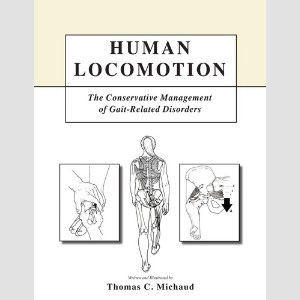
Thomas Michaud, D.C.
Special Introductory Price!
To order, please call the lab at:
(800)942-2272
Book Review by Greg Wolfe:
Dr. Michaud’s latest book on human locomotion, “The Conservative Management of Gait-Related Disorders”, is a comprehensive elaboration on his previous text, “Foot Orthoses and Other Forms of Conservative Foot Care”. In this edition he moves from focusing on foot disorders and orthotic applications to analyzing and treating system wide gait dysfunction. Integrated descriptions of foot function and its role in gait remains foundational for the author, not only in his practice, but in his latest descriptions of efficient and inefficient gait. The book is not only intended for anyone treating human locomotion anomalies, but includes all of the basic foot function ground work that he asserts in his initial text.
He dedicates the whole first chapter to paleoanthropological concepts that distinguish the use and development of anatomical formations for accomplishing bipedal locomotion. This kind of intricacy in the progression to homo-erectus transport is manna for evolutional theorists wanting explanations for changes in anatomical form as it relates to human function. It’s mostly impractical for practitioners less inclined to delineate between progressive patterns to influence their problem solving skills.
Dr. Michaud’s perspective on interrelationships between segments throughout the lower half of the body is further displayed in this volume by his proliferate use of graphic diagrams he illustrated himself. Though there are not as many intricate foot illustrations, the ones that are there better serve his specificity in describing form and shape of linkages that affect segments and muscle function up and down the kinetic chain.
After reiterating what comprises ideal human gait, this book also goes into exhaustive detail describing how pelvic to foot kinetic events and kinematic actions contribute to abnormal motions in gait. Assessments for restrictions in range motion, tightness in muscles and sensory motor disorders that contribute to locomotor dysfunction are described with voluminous annotation.
The later chapters include one on orthotic therapy as a viable modality, that has a table for trouble shooting orthoses do not achieve their desired result. Anyone who’s faced a situation where a patient complained about their “Orthotics” will appreciate Dr. Michaud’s matrix for determining what should be done next. The next chapter on shoes continues describing the regimen on application of foot orthoses by detailing how materials and the construction will influence their effectiveness.
The ending chapter on treatment protocols is where Dr. Michaud once again inserts practical explanations for applications that clinicians will find effective. Symptomatology as it relates to certain disorders is cataloged for the reader, together with each ideological progression and a corresponding treatment plan.
This book offers far more than what his original text provided, particularly since he expanded it to endorse many more regimes for treating gait anomalies. The foot in gait is that much more understandable as it relates to the whole engine and linkage system thanks to Dr. Michaud’s effort.